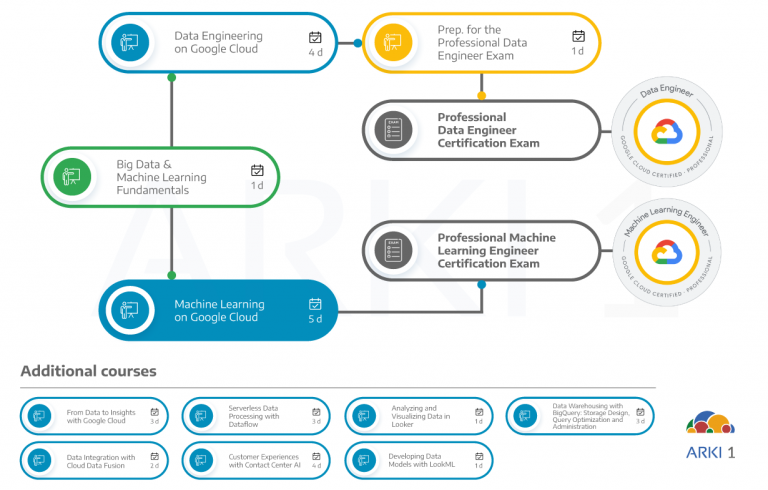This course introduces the artificial intelligence (AI) and machine learning (ML) offerings on Google Cloud that support the data-to-AI lifecycle through AI foundations, AI development, and AI solutions. It explores the technologies, products, and tools available to build an ML model, an ML pipeline, and a generative AI project. You learn how to build AutoML models without writing a single line of code; build BigQuery ML models using SQL, and build Vertex AI custom training jobs by using Keras and TensorFlow. You also explore data preprocessing techniques and feature engineering.
Objectives
In this course, participants will learn the following skills:
- Describe the technologies, products, and tools to build an ML model, an ML pipeline, and a Generative AI project.
- Understand when to use AutoML and BigQuery ML.
- Create Vertex AI-managed datasets.
- Add features to the Vertex AI Feature Store.
- Describe Analytics Hub, Dataplex, and Data Catalog.
- Describe how to improve model performance.
- Create Vertex AI Workbench user-managed notebook, build a custom training job, and deploy it by using a Docker container.
- Describe batch and online predictions and model monitoring.
- Describe how to improve data quality and explore your data.
- Build and train supervised learning models.
- Optimize and evaluate models by using loss functions and performance metrics.
- Create repeatable and scalable train, eval, and test datasets.
- Implement ML models by using TensorFlow or Keras.
- Understand the benefits of using feature engineering.
- Explain Vertex AI Model Monitoring and Vertex AI Pipelines.
Audience
This class is primarily intended for the following participants:
• Aspiring machine learning data analysts, data scientists, and data engineers
• Learners who want exposure to ML and use Vertex AI, AutoML, BigQuery ML, Vertex AI Feature Store, Vertex AI Workbench, Dataflow, Vertex AI Vizier for hyperparameter tuning, and TensorFlow/Keras.
Prerequisites
To get the most of out of this course, participants should have:
- Some familiarity with basic machine learning concepts.
- Basic proficiency with a scripting language – Python preferred.
Duration
40 hours (5 days)
Investment
Check the next open public class in our enrollment page.
If you are interested in a private training class for your company, contact-us.
Course Outline
The course includes presentations, demonstrations, and hands-on labs.
- Recognize the AI/ML framework on Google Cloud.
- Identify the major components of Google Cloud infrastructure.
- Define the data and ML products on Google Cloud and how they support the data-to-AI lifecycle.
- Build an ML model with BigQueryML to bring data to AI.
- Define different options to build an ML model on Google Cloud.
- Recognize the primary features and applicable situations of pre-trained APIs, AutoML, and custom training.
- Use the Natural Language API to analyze text.
- Define the workflow of building an ML model.
- Describe MLOps and workflow automation on Google Cloud.
- Build an ML model from end-to-end by using AutoML on Vertex AI.
- Define generative AI and large language models.
- Use generative AI capabilities in AI development.
- Recognize the AI solutions and the embedded generative AI features.
- Describe how to improve data quality.
- Perform exploratory data analysis.
- Build and train supervised learning models.
- Describe AutoML and how to build, train, and deploy an ML model without writing a single line of code.
- Describe BigQuery ML and its benefits.
- Optimize and evaluate models by using loss functions and performance metrics.
- Mitigate common problems that arise in machine learning.
- Create repeatable and scalable training, evaluation, and test datasets.
- Create TensorFlow and Keras machine learning models.
- Describe the TensorFlow main components.
- Use the tf.data library to manipulate data and large datasets.
- Build a ML model that uses tf.keras preprocessing layers.
- Use the Keras Sequential and Functional APIs for simple and advanced model creation.
- Train, deploy, and productionalize ML models at scale with the Vertex AI Training Service.
- Describe Vertex AI Feature Store.
- Compare the key required aspects of a good feature.
- Use tf.keras.preprocessing utilities for working with image data, text data, and sequence data.
- Perform feature engineering by using BigQuery ML, Keras, and TensorFlow.
- Understand the tools required for data management and governance.
- Describe the best approach for data preprocessing: From providing an overview of Dataflow and Dataprep to using SQL for preprocessing tasks.
- Explain how AutoML, BigQuery ML, and custom training differ and when to use a particular framework.
- Describe hyperparameter tuning by using Vertex AI Vizier to improve model performance.
- Explain prediction and model monitoring and how Vertex AI can be used to manage ML models.
- Describe the benefits of Vertex AI Pipelines.
- Describe best practices for model deployment and serving, model monitoring, Vertex AI Pipelines, and artifact organization.


